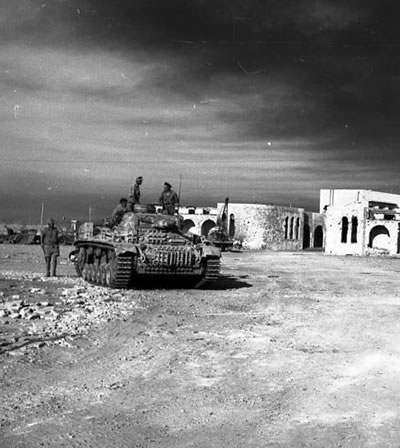In June 1942, during World War II, the city of Tobruk, Libya fell to Axis forces.
At the end of 1941, Allied forces had liberated Tobruk.
Axis troop retreated to Gazala, and then to El Agheila.
Rommel then reorganized his forces in order to improve communication between artillery, infantry and armored forces.
He then redirected his forces toward Tobruk in an attempt to regain the city.
 The Germans had many half-tracked vehicles, which could move easily in the desert.
The Germans had many half-tracked vehicles, which could move easily in the desert.
In addition, the Germans had developed a new strategy of leapfrogging anti-tank batteries from one position to another along with panzers.
Axis forces were able to destroy many British units and capture a great deal of supplies.
Rommel planned to use Italian infantry to attack the northern sector of the British front.
German tanks would then attack from the south, forming a right hook and moving upwards so that the British were forced to move north.
The British would then be surrounded and pinned against the sea.
Italian forces attacked from the north on May 26, 1942.
Panzers attacked from the south the next day.
Axis forces had been weakened as the supply line had grown longer, and British strategy was focused on not allowing the enemy to capture supplies.
The British defensive line at Gazala was made up of brigade “boxes” that were protected by minefields.
British forces were dispersed, with each British division being divided into three brigade groups. Artillery and other supports were shared between the brigades equally, instead of being focused under a central command.
Some brigades themselves were broken down in order to support the infantry.
Armored forces were also dispersed.
Initially, Axis units were able to scatter or destroy some British units.
However, the British were now equipped with M3 General Lee medium tanks (modified versions of the General Grant used by US forces.)
The only Axis tank that was a match for the General Lee at the time was the PzKpfw III, and the British had many more General Lees than the Germans had PzKpfw IIIs.
To compensate for the numerical disadvantage, the Germans redeployed several antitank batteries.
Heavy fighting took place throughout the day.
By May 27, the 21st Panzer Division was approaching the British forces’ vital supply line at the coast road.
However, the Germans themselves were short on fuel and ammunition.
A minefield, as well as two infantry brigade boxes, had cut them off from supplies.
British armored forces then moved forward.
But the British minefields had huge gaps, and before the British were able to get to the trapped German divisions, the Germans found a gap in the minefield.
Although Rommel was exposed and nearly surrounded, he decided to take an offensive position.
He planned to destroy the nearest British brigade so that the gap would be wide enough for his forces to go through and obtain supplies.
Rommel’s troops would then go on the offensive.
On June 5, the British launched an attack.
However, the British offensive was a failure.
Artillery support was off target.
Emplaced German artillery and antitank guns shot up the British forces that broke through the first German line.
Some British units got lost in their own covering smokescreens.
The British did not have good antitank guns. The 2-pounder guns used by the British could not penetrate heavy German tank armor.
As the British attack seemed to fall apart, the Germans began their counterattack.
By dusk, the British had lost more than 200 tanks out of the 400 they had started with.
Axis forces, on the other hand, had started with 230 tanks but lost only about 23.
The British did not have good radio discipline, and Rommel was able to use this to his advantage, gaining information about British positions, strengths and strategies.
On June 14, the British began to retreat from Gazala.
The British formed an armored covering force to protect retreating units that came under attack.
Tobruk was left isolated, and Allied forces surrendered on June 21.